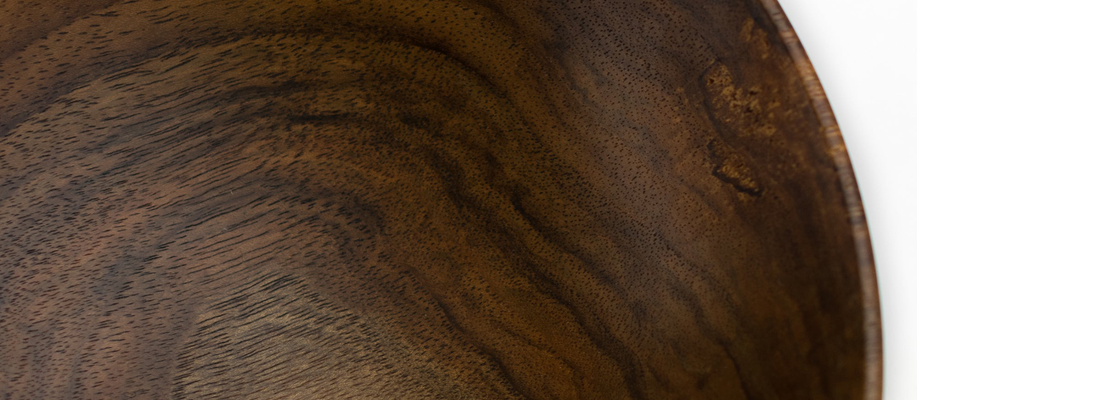
wood varieties
Share
Craftspeople are spoilt for choice when it comes to wood variety in BC, and so are those shopping for wooden pieces. Read on to learn about the varieties of wood most common at CCBC, how to tell them apart and why it matters.
This post is an excerpt from pondercraft.ca, CCBC's educational website.
Different types of wood have different qualities. This means different woods are better suited for certain uses. Access or availability will also affect whether an artist decides to work with a certain type of wood.
arbutus

Identifying Features: Also known as Madrone, arbutus is appreciated for its richness of grain, variance and beautiful finishes. It is found in a range of colours including pale white to dark brown, with shades of pinks, browns and reds in between. Arbutus is also known for its burl veneer – referring to its surplus amount of closely packed knots and swirled grain giving its wood products a unique pattern.
Properties: Arbutus trees are marked as a rare and endangered species in BC, so make sure your product was made from ethically sourced wood. Considered one of the best exotic hardwoods in the world, arbutus trees grow from Northern California to Southern BC, specifically the Gulf Islands. They generally grow within 8 km of the ocean, clinging to coasts and exposed rocky bluffs. Most notably, arbutus trees can survive in harsh climates, from wet and windy winters to droughts in the summer; making it very suited to Vancouver’s weather. Arbutus is a very heavy, hard and brittle wood, making it a very difficult wood to dry, often warping, twisting or cracking upon drying. However, it is an excellent turning wood, also taking well to stains and finishes. Its workability is similar to hard maple – able to withstand both hand tools and machines.
Common Uses: Pieces made from arbutus are typically smaller items, due it its rarity and the legalities surrounding sourcing the wood for artisan and commercial value. Some examples include salad utensils, jewelry, wooden sculptures and other art pieces. Arbutus makes great echo-friendly products, as it is typically harvested from fallen down trees and dead branches.
cherry

Identifying Features: Cherry is a light shade of pink-brown when freshly cut, but darkens into a deeper golden brown once exposed to sunlight. It has a close grain that is either straight, or just slightly wavy, consisting of a fine to medium texture.
Properties: Cherry is easy to work with, by both machine and hand tools. It also glues, turns and finishes with notable ease. However, it is difficult to stain due to its fine and close grain, sometimes resulting in blotchy patches.
Common Uses: Products made out of cherry are often functional and found in the home, including cabinetry, fine furniture, flooring, as well as specialty wood items such as bowls, platters and jewelry boxes.
elm

Identifying Features: Elm trees can grow to great heights, having long, straight trunks. They make up many of the ornamental, garden and park trees seen across North America, Europe and the Southern Hemisphere.
Properties: Originating in what is now known as central Asia, elm trees can be quite large in size, but many die from Dutch Elm disease before reaching their full growth. They are valued for their interlocking grain, making their wood highly pliable and resistant to splitting. Additionally, elm is resistant to decay when permanently wet.
Common Uses: Since elm bends well, their wood is often used for wagon wheel hubs and archery bows, as well as chair seats and coffins. Their long and straight trunks and resistance to decay make them ideal for keels (hydrodynamic parts) in ship construction. Historically, the body of Japanese Taiko drums were often cut from wood of old elm trees, their non-split wood optimal for nailing skins into.
maple

Identifying Features: Hard maples are a light red-brown colour with a straight grain, sometimes with burls or defects. Soft maple’s colour ranges from tan to grey, often with extreme variation within a single piece of wood.
Properties: Generally, maple is a solid wood-working material. While good with machine and hand tools, it does tend to burn if machined with high-speed cutters. Maple is often finished with a clear coat, as staining is difficult with its straight, tight grain – like cherry, stains leave a blotchy finish. North American maple is typically divided into two categories: hard and soft. Hard maple, or sugar maple, is heavy, strong and stiff, with a uniform texture allowing it to be sanded to a beautiful finish. Hard maple is also resistant to abrasion and shock. Soft maples, including silver, red maple and boxelder, are much like hard maples but lighter in density. As far as wood, soft maple is still quite hard. Its name simply refers to its softness in comparison to hard maple – the two are fairly interchangeable.
Common Uses: Hard maple can be used in flooring, musical instruments and smaller items such as cutting boards, baseball bats and novelty items. Hard maple is good for cutting boards, as its fine grain has a capillary nature which pulls fluids from food downward, trapping bacteria which is then killed off as the board dries. Softer wood has larger grain making it more prone to splitting, forming grooves which bacteria can fester over repeated use. Instead, soft maple is used for boxes, crates, musical instruments and novelty items.
plum
Identifying Features: Plum has a fine texture with a close grain, often with swirled or irregular patterns. It can be found in a wide range of colours, exhibiting streaks of pink, orange, red, purple, olive and grey mixed into its base of yellow-brown heartwood.
Properties: Knots and other defects are a common attribute, due to the plum tree’s small size. Though related to cherry, plum tends to be heavier and harder, and much scarcer. It also a very hard wood, well suited for northern Canada conditions. Plum glues, turns and finishes well; it just requires a more skilled woodworker to carefully manoeuvre around knots and defects.
Common Uses: Plum items found around the home include smaller, more decorative products, a result of the plum trees’ small trunk sizes. Some examples include turned bowls, musical instruments, utensil handles and inlay in furnishings such as cabinetry and tables.
red alder

Identifying Features: Red Alder is the most commonly found wood in the Pacific Northwest and varies in colour from a light tan to a reddish brown, usually having a fine, straight grain.
Properties: Red Alder is known for being easy to work by both machine and hand tools. It is also glues, stains and finishes well, making it a popular wood choice.
Common Uses: Red Alder can be used to make furniture, cabinetry, millwork, plywood, and musical instruments. It is a very important commercial lumber.
walnut

Identifying Features: Walnut is the only North American wood that has a rich, dark-coloured grain. While usually straight, walnut grain can sometimes curl with burls and other defects.
Properties: Walnut is easy to work with by machine or hand tools, producing crisp details in finished pieces – a great quality for inlay. It is a popular material for fine furniture, as it does not damage easily, rarely has sap pockets (which can diminish a work by leaving behind blemishes), while its dark wood hides any scratches. Walnut also takes well to fasteners and glue. All these reasons make walnut a very reliable wood, making it favoured among woodworkers.
Common Uses: The workability and durability of walnut makes it great for furniture, cabinetry and interior panelling, as well as novelty items.
yew
Identifying Features: Yew is a darker heartwood, ranging from orange-brown to purple and magenta hues, that darkens further with age. It has a thin, scaly brown bark, with an off-white sapwood layer. Yew is a straight-grained wood, with a fine, uniform texture.
Properties: Yews are a small to medium-sized evergreen species, with little to no concern for endangerment, as its population is steadily growing. Found in Southern BC, yews are shade tolerant, typically growing along streams in drier environments. They are closed-pored with great elasticity, one of the hardest of the softwoods. Yew is very easy to woodwork with, as it also glues, finishes and turns well.
Common Uses: Due to its elasticity, yew is often used in items that are springy, such as bow and arrows or musical instruments, yew a well-known material for the Lute. Traditionally, Native Americans used it for bows and canoe paddles. Meanwhile, in Japan it is used for decorative purposes.
Learn more about clay and other craft mediums at ponder craft and design, CCBC's educational website.
cover image: Black Walnut Bowl - Neno Catania
in-text: Arbutus Server XL #2 - Ron Bazar, Wedding Goblet - Neno Catania, Elm Candy Dish #1615 - Allan Cusworth, Maple Goblet #1305 - Allan Cusworth, Alder Vase #0825 - Allan Cusworth, Black Walnut Bowl - Neno Catania
